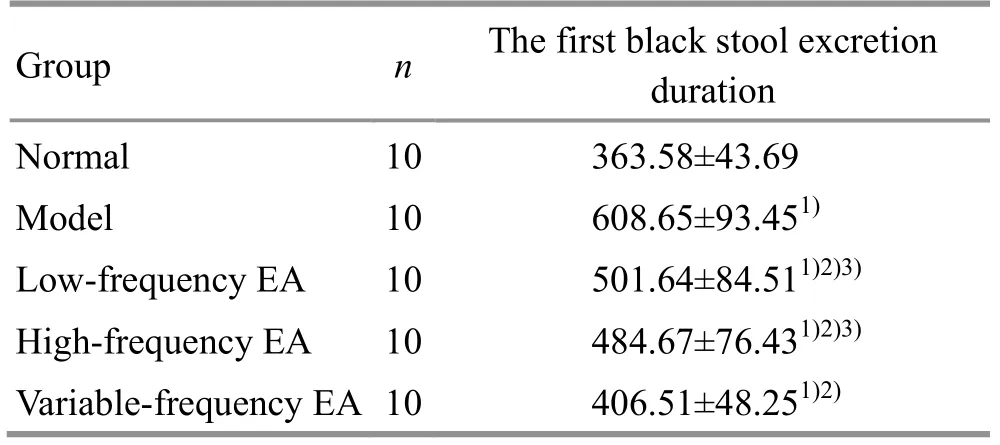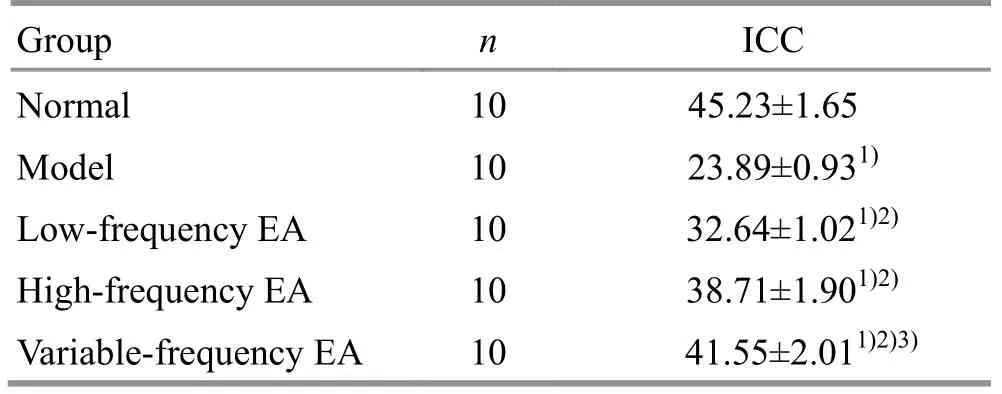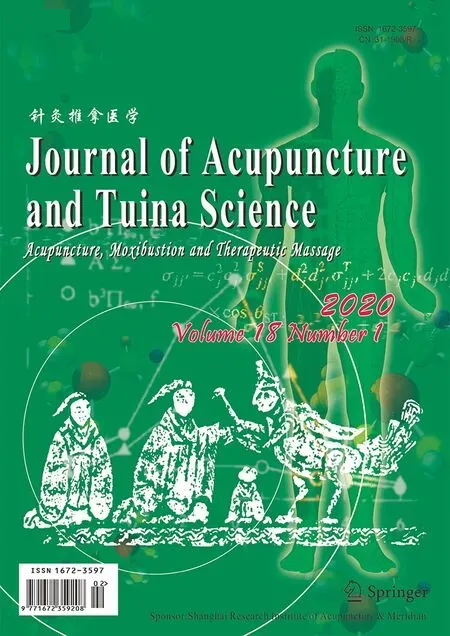Effects of electroacupuncture of different frequencies on electromyography, NOS and ICC of colon in rats with slow transit constipation
Liu Bo-xin (刘博鑫), Zhao Bo (赵博), Gao Fei (高飞), Liu Yan-li (刘艳丽), Li Xiao-feng (李晓峰), Zhang Shen (张莘),Zhang Hui-zhen (张会珍), Liang Yu-lei (梁玉磊), Zhang Xuan-ping (张选平), Sun Yan-hui (孙彦辉), Jia Chun-sheng (贾春生)
Hebei University of Chinese Medicine, Shijiazhuang 050200, China
Abstract
Keywords: Acupuncture Therapy; Electroacupuncture; Constipation; Electromyography; Nitric Oxide Synthase; Colon;Rats
Constipation is one of the most common clinical symptoms of digestive tract.It often manifests as decreased defecation frequency, dry stools, and/or difficulty in defecation.At present, chronic constipation is usually divided into 4 clinical types: slow transit constipation (STC), outlet obstructive constipation,mixed constipation and normal transit constipation[1].STC is a common type of constipation characterized by prolonged transit time and reduced high amplitude contraction of the colon after intake of food.At the same time, STC may also be accompanied by the gastrointestinal disorders caused by other autonomic dysfunctions, such as delayed gastric emptying or intestinal motility disorders[2].The pathogenesis and etiology of STC are unclear.However, some studies have shown that abnormal changes in the frequency and amplitude of colon electromyography may be an important factor in STC rats leading to the slow colonic transmission[3].Besides, gastrointestinal hormone nitric oxide synthase (NOS) may also play an important role in the regulation of intestinal motility by acupuncture[4].Some researchers have found that the etiology and pathogenesis of STC are related to the distribution and expression of the interstitial cells of Cajal (ICC).Decreased ICC is a key factor in colonic motility disorders in STC patients.Therefore, the role of ICC in constipation pathogenesis has drawn increasing attention[5].
In recent years, the related research on acupuncture treatment of constipation has been changing rapidly[6-7],and electroacupuncture (EA) has achieved good results in treating STC[8-9].However, the application of EA frequencies is confusing and lacks a scientific uniform standard.In this study, Tianshu (ST 25), Zusanli (ST 36)and Zhigou (TE 6) were selected to observe the effects of EA of different frequencies on the colonic transmission function, NOS level and C-kit positive cell area andin vivocolonic electromyography of the STC rats, to explore the appropriate frequency and provide an objective basis for EA treatment of STC.
1 Materials
1.1 Animals
Fifty healthy male Wistar rats, weighing 200-300 g,were provided by the Experimental Animal Center of Hebei Medical University [Certificate No.: SCXK (Ji)2013-1-003].All rat handling methods were in accordance with the relevant ethical regulations of the Animal Management Committee of Hebei University of Chinese Medicine and theGuiding Opinions on the Treatment of Experimental Animalsissued by the Ministry of Science and Technology of the People's Republic of China in 2006.
1.2 Equipments and medicine
Hwato brand acupuncture needles and SDZ-Ⅲelectronic acupuncture apparatus (Jiangsu Medical Supplies Co., Ltd., China); BIOPAC multi-channel physiological recorder (BIOPAC, USA); compound diphenoxylate (lot number: 17020336, Xinxiang Changle Pharmaceutical Factory, Henan Province, China);automatic biological tissue dehydration machine, tissue embedding machine, pathological tissue slicer, drying slice machine, microscope, and image acquisition system were provided by the Experimental Center of Hebei University of Chinese Medicine.
1.3 Reagents
NOS assay kit (Nanjing Jiancheng Bioengineering Research Institute, China); CD117 and DAB color development kit (Beijing Biosynthesis Biotechnology Co.,Ltd., China).
2 Methods
2.1 Grouping and model preparation
The fifty rats were housed in cages (5 rats in each cage) with a clean, quiet, ventilated breeding environment at 16-25 ℃, humidity of 50%-70% and light of 12 h/d.Rats were free access to the diet and water.
From the 50 rats, 10 were randomly selected as a normal group and fed with ordinary diet, and the remaining 40 were used to establish the STC models with the compound diphenoxylate added into the diet at a dose of 8 mg/(kg·bw) each day for continuous 120 d.The 40 successfully established STC model rats were randomly divided into a model group, a low-frequency EA group (2 Hz), a high-frequency EA group (100 Hz), and a variable-frequency EA group(2 Hz/100 Hz), with 10 rats in each group.The diet was prepared by the Experimental Animal Center of Hebei Medical University.
2.2 Treatment methods
2.2.1 Three EA groups
Acupoints: Tianshu (ST 25), Zhigou (TE 6) and Zusanli(ST 36).
Methods: The acupoint locations were determined according to theInstruction for Experiments in Experimental Acupuncture Science[10]and the principle of acupoint selection between experimental animals and humans.The rats were placed on a home-made rat plate.The needles of 0.35 mm in diameter and 25 mm in length were punctured into about 5 mm after the acupoints were routinely sterilized, then connected to a Hwato brand electronic acupuncture apparatus.The 2 Hz continuous wave was used for the low-frequency EA group; the 100 Hz continuous wave was used for the high-frequency EA group; the sparse-dense wave(2 Hz/100 Hz) was used for the variable-frequency EA group.The used electric current intensity (about 2.0 mA)was to produce a slightly trembling of rat's limbs without causing painful screams.The treatment lasted for 15 min each time, once a day for a total of 15 d.
2.2.2 Normal and model groups
Rats in the normal and the model groups were placed on the rat plate in the same body position without any treatment, for 15 min each time, once a day for a total of 15 d.
2.3 Observation items
2.3.1 Colonic transmission function
The first black stool excretion duration was measured by the activated carbon gavage.To reduce the influence of the instrument and human factors on the experimental results, rats were fasted for 24 h after the treatment was stopped for 1 week, and 2 mL of 100 g/L activated carbon suspension was taken by gavage.The time from the completion of the gavage to the discharge of the first black stool was recorded.
2.3.2In vivocolonic electromyography
After fasting for 24 h, the rats were anesthetized by intraperitoneal injection of 10% chloral hydrate[3 mg/(kg·bw)].A longitudinal incision about 3 cm was made in the middle of the abdomen after the abdomen was shaved and disinfected.The positive and negative copper wires of the physiological recorder were placed in the proximal colon (approximately 1.5 cm from the cecum), with a 1 cm distance between the positive and negative electrodes.The copper wires were fixed to the colon wall, and the leads were connected to the physiological recorder through the incision.Recording was started with a BIOPAC multi-channel physiological recorder after 30 min and continued for 1 h.The average values of each rat colonic electromyography frequency and amplitude were calculated first.Then the mean and standard deviation of the colonic electromyography frequency and amplitude of 10 rats in the same group were further calculated.
2.3.3 Colonic NOS
The rats were sacrificed by cervical relocation, and the middle section of the colon (about 2 cm in length)was quickly isolated.Normal saline 2 mL was added,after the blood stains were removed, to grind the isolated colon into homogenate.Centrifuged at 3 000 r/min and 4 ℃ for 4 min, the supernatant was then stored in -20 ℃ refrigerator.The colorimetric method was used to determine the colonic NOS using a NOS assay kit.
2.3.4 C-kit positive cell area in colon
After the rats were sacrificed, rat colons of approximately 2 cm near the anus were isolated, rinsed with normal saline, fixed with 10% neutral formaldehyde solution, and routinely sliced for hematoxylin-eosin (HE) staining and dewaxing; washed with PBS; incubated with primary monoclonal C-kit antibody at 37 ℃ for 90 min; incubated with secondary antibody for 30 min at room temperature;color developed with DAB for 10 min; counterstained with hematoxylin for 8 min followed by re-blue with tap water for 10 min.After stepwise dehydration, it was transparent and sealed.Brown cytoplasm indicated C-kit positive cells (ICC) under the light microscope.Ten high-power (×400) fields of view for each slice were randomly selected using the Image-Pro Plus 7.0 image analysis software.The area of C-kit receptor-positive cells was measures to calculate the average value, and the ICC express was represented by the area difference.
2.4 Statistical analysis
All data were subjected to statistical analysis using SPSS 21.0 statistical software.Measurement data were expressed as mean ± standard deviation (±s), and statistical analysis was performed by one-way analysis of variance.P<0.05 indicated that the difference was statistically significant.
3 Results
3.1 Comparison of colonic transmission function
Compared with the normal group, the first black stool excretion duration was significantly longer in the other groups (allP<0.05).Compared with the model group,the first black stool excretion duration was significantly shortened in the three EA groups (allP<0.05); the duration was significantly shorter in the variablefrequency EA group than in the low-frequency EA and the high-frequency EA groups (allP<0.05), (Table 1).
Table 1.Comparing the first black stool excretion duration of rats among groups (±s, min)

Table 1.Comparing the first black stool excretion duration of rats among groups (±s, min)
Note: Compared with the normal group, 1) P<0.05; compared with the model group, 2) P<0.05; compared with the variablefrequency EA group, 3) P<0.05
Group n The first black stool excretion duration Normal 10 363.58±43.69 Model 10 608.65±93.451)Low-frequency EA 10 501.64±84.511)2)3)High-frequency EA 10 484.67±76.431)2)3)Variable-frequency EA 10 406.51±48.251)2)
3.2 Comparison of colonic electromyography
Compared with the normal group, the amplitudes were significantly increased and the frequencies were increased in the rat colonic electromyography in the other groups (allP<0.05); compared with the model group, the amplitudes were significantly decreased and the frequencies were decreased in the three EA groups(allP<0.05); compared with the low-frequency and the high-frequency EA groups, the amplitude and frequency were reduced in the variable-frequency EA group (bothP<0.05), (Table 2).
3.3 Comparison of colonic NOS content
Compared with the normal group, the NOS contents in the other groups were increased significantly (allP<0.05); compared with the model group, the NOS contents in the three EA groups were significantly reduced (allP<0.05); the NOS content in the variable-frequency EA group was significantly lower than in the low-frequency and the high-frequency EA groups (bothP<0.05), (Table 3).
3.4 Comparing the area of C-kit positive cells in rat colon among groups
Compared with the normal group, the areas of C-kit positive cells (ICC) in the other groups were significantly reduced (allP<0.05); compared with the model group,the areas of C-kit positive cells in the three EA groups were increased significantly (allP<0.05); compared with the low-frequency EA group, the area of C-kit positive cells in the variable-frequency EA group was increased significantly (P<0.05), (Table 4).
Table 2.Comparing frequency and amplitude in colonic electromyography among groups (±s)

Table 2.Comparing frequency and amplitude in colonic electromyography among groups (±s)
Note: Compared with the normal group, 1) P<0.05; compared with the model group, 2) P<0.05; compared with the variablefrequency EA group, 3) P<0.05
Group n Normal 10 Model 10 Low-frequency EA 10 High-frequency EA 10 Variable-frequency EA 10 Amplitude Frequency(mV)(time/min)0.19±0.04 13.67±1.69 0.64±0.211)21.63±9.861)0.37±0.151)2)3)17.64±3.631)2)3)0.40±0.191)2)3)18.36±4.121)2)3)0.25±0.0971)2)15.20±2.371)2)
Table 3.Comparison of rat colonic NOS content among groups (±s, U/mL)

Table 3.Comparison of rat colonic NOS content among groups (±s, U/mL)
Note: Compared with the normal group, 1) P<0.05; compared with the model group, 2) P<0.05; compared with the variablefrequency EA group, 3) P<0.05
?
Table 4.Comparing the areas of C-kit positive cells in rat colon among groups (±s, ×104 μm2)

Table 4.Comparing the areas of C-kit positive cells in rat colon among groups (±s, ×104 μm2)
Note: Compared with the normal group, 1) P<0.05; compared with the model group, 2) P<0.05; compared with the lowfrequency EA group, 3) P<0.05
?
4 Discussion
Traditional Chinese medicine believes that the main causes of constipation are dryness-heat stagnated in the interior, the qi movement stagnation, the deficiency of body fluid and the spleen-kidney yang deficiency.The disease is located in the large intestine, but it is closely related to the lung, spleen and kidney.The deficiency(spleen deficiency) is the main factor.The dysfunction of spleen in transportation and the weak conduction of the large intestine are the fundamental causes of STC[11].Therefore, the fundamental treatment principle of acupuncture for STC is to promote defecation by strengthening the spleen and reinforcing qi.EA combining the dual stimulation of needle and pulse current enhances the transmission function of the large intestine.Tianshu (ST 25) is the Front-Mu point of the large intestine.Acupuncture at Tianshu (ST 25) can regulate qi-flow to unblock stagnation to improve the large intestinal peristalsis.Zusanli (ST 36) is the He-Sea point of the Stomach Meridian and the Lower He-Sea point of the stomach.Acupuncture at Zusanli (ST 36)can benefit qi and unblock the organs to enhance the function of the spleen and stomach.Zhigou (TE 6) is the best point to regulate the three Jiao (triple energizer) to unblock and regulate the intestines for defecation.As the common acupoints for STC, the combination of the three acupoints can strengthen the spleen and invigorate qi for defecation[6].
Colonic electromyography activities (frequency and amplitude) can be used as an objective electrophysiological indicator reflecting the colonic function[12].At the same time, gastrointestinal hormone NOS may also play an important role in the regulation of intestinal motility by acupuncture[4].NOS is an essential substance that catalyzes L-arginine to produce gas signal molecule nitric oxide (NO).In the digestive system, NO is a non-adrenal non-cholinergic neurotransmitter, and maintains the normal mobility function of the gastrointestinal tract together with cholinergic neurotransmitters and adrenergic neurotransmitters[7].NOS is the only rate-limiting enzyme during NO synthesis.Changes in its activity directly affect the amount of NO production and its biological effects[13].Because NOS is a key inhibitory neurotransmitter in the enteric nervous system, its role in the pathogenesis of constipation has received widespread attention[14].NOS is widely present in human gastrointestinal tissues, and studies have confirmed that acupuncture regulates the activity of NOS in gastrointestinal tissues and improves the gastrointestinal motility[15].
The results of this study showed that from the perspective of colonic transmission function, compared with the model group, the first black stool excretion durations of rats in the three EA groups, especially in the variable-frequency EA group, were significantly shortened.It’s showed that 2 Hz/100 Hz variablefrequency EA promoted the defecation function of STC rats to a certain extent.From the perspective of colonic electromyography, EA, especially 2 Hz/100 Hz variablefrequency EA, normalized the frequency and amplitude of the colonic electromyography of STC rats, thereby regulating the normal motility function of the intestine.From the perspective of colonic NOS content, EA,especially 2 Hz/100 Hz variable-frequency EA, reduced the colonic NOS content of rats, thereby regulating the enteric nervous system and improving the intestinal transmission function.
Related studies have shown that ICC is a pacemaker cell for gastrointestinal electricity.Therefore, the role of ICC in colonic transmission function has received increasing attention[16].ICC is both the interstitial cell associated with gastrointestinal motoneurons and the cell associated with smooth muscle in the gastrointestinal tract[17].Studies have found that the intestinal ICC number is an important observation indicator for studying constipation[18-19].C-kit receptor is the specific marker of intestinal ICC.The ICC expression can be measured by C-kit receptor-positive cells to further study the mechanism of constipation[20-21].
The onset of STC is related to the abnormality of certain gastrointestinal regulatory peptides.The excitatory neurotransmitters mainly include colon substance P (SP), and the inhibitory neurotransmitters mainly include vasoactive intestinal peptide (VIP).We have studied the effects of EA of different frequencies on SP and VIP in the colon of STC rats, and the selected EA frequency referred to the relevant clinical studies[22].Based on previous studies, this study observed the effects of EA of different frequencies on the colonic electromyography frequency and amplitude, NOS content and ICC expression in STC rats, and further clarified the appropriate frequency of EA for STC.Our results showed that compared with the high-frequency(100 Hz) and the low-frequency (2 Hz) EA, the 2 Hz/100 Hz variable-frequency EA was more effective in improving colonic transmission function, the frequency and amplitude of electromyography in STC rats, to make the colonic ICC expression closer to the normal level.This result will provide a basis for choosing the appropriate EA frequency in the treatment of STC.
 Journal of Acupuncture and Tuina Science2020年1期
Journal of Acupuncture and Tuina Science2020年1期
- Journal of Acupuncture and Tuina Science的其它文章
- Effect of electroacupuncture on the learning and memory abilities in type 2 diabetic model rats with cognitive impairment
- Effects of electroacupuncture on conjunctival cell apoptosis and the expressions of apoptosis-related proteins Caspase-3, Fas and Bcl-2 in rabbits with dry eye syndrome
- Acupuncture for premature ovarian insufficiency:a systematic review and meta-analysis
- Therapeutic efficacy and mechanism of heat-sensitive moxibustion for adjuvant treatment of depression in Parkinson disease
- Clinical study on Jin’s three-needle therapy for post-stroke cognitive impairment
- Therapeutic efficacy and mechanism of heat-sensitive moxibustion for vascular dementia
